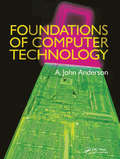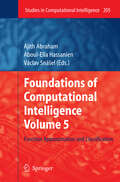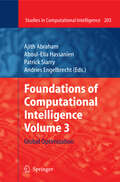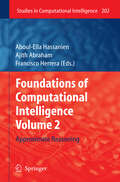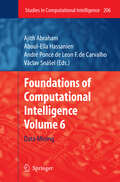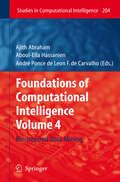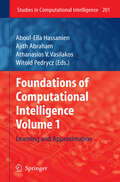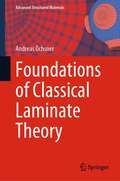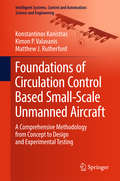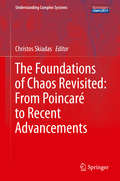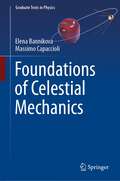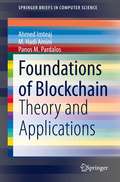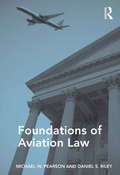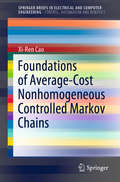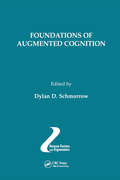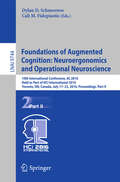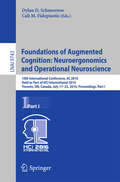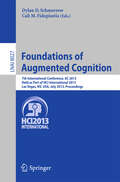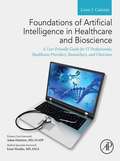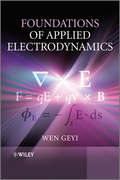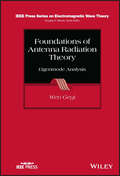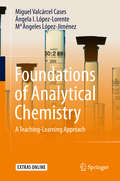- Table View
- List View
Foundations of Computer Technology
by Alexander John AndersonFoundations of Computer Technology is an easily accessible introduction to the architecture of computers and peripherals. This textbook clearly and completely explains modern computer systems through an approach that integrates components, systems, software, and design. It provides a succinct, systematic, and readable guide to computers, providing a springboard for students to pursue more detailed technology subjects.This volume focuses on hardware elements within a computer system and the impact of software on its architecture. It discusses practical aspects of computer organization (structure, behavior, and design) delivering the necessary fundamentals for electrical engineering and computer science students. The book not only lists a wide range of terms, but also explains the basic operations of components within a system, aided by many detailed illustrations. Material on modern technologies is combined with a historical perspective, delivering a range of articles on hardware, architecture and software, programming methodologies, and the nature of operating systems. It also includes a unified treatment on the entire computing spectrum, ranging from microcomputers to supercomputers.Each section features learning objectives and chapter outlines. Small glossary entries define technical terms and each chapter ends with an alphabetical list of key terms for reference and review. Review questions also appear at the end of each chapter and project questions inspire readers to research beyond the text. Short, annotated bibliographies direct students to additional useful reading.
Foundations of Computational Intelligence Volume 5: Function Approximation and Classification (Studies in Computational Intelligence #205)
by Ajith Abraham Aboul-Ella Hassanien Vaclav SnáselFoundations of Computational Intelligence Volume 5: Function Approximation and Classification Approximation theory is that area of analysis which is concerned with the ability to approximate functions by simpler and more easily calculated functions. It is an area which, like many other fields of analysis, has its primary roots in the mat- matics. The need for function approximation and classification arises in many branches of applied mathematics, computer science and data mining in particular. This edited volume comprises of 14 chapters, including several overview Ch- ters, which provides an up-to-date and state-of-the art research covering the theory and algorithms of function approximation and classification. Besides research ar- cles and expository papers on theory and algorithms of function approximation and classification, papers on numerical experiments and real world applications were also encouraged. The Volume is divided into 2 parts: Part-I: Function Approximation and Classification – Theoretical Foundations Part-II: Function Approximation and Classification – Success Stories and Real World Applications Part I on Function Approximation and Classification – Theoretical Foundations contains six chapters that describe several approaches Feature Selection, the use Decomposition of Correlation Integral, Some Issues on Extensions of Information and Dynamic Information System and a Probabilistic Approach to the Evaluation and Combination of Preferences Chapter 1 “Feature Selection for Partial Least Square Based Dimension Red- tion” by Li and Zeng investigate a systematic feature reduction framework by combing dimension reduction with feature selection. To evaluate the proposed framework authors used four typical data sets.
Foundations of Computational Intelligence Volume 3: Global Optimization (Studies in Computational Intelligence #203)
by Ajith Abraham Aboul-Ella Hassanien Patrick Siarry Andries EngelbrechtGlobal optimization is a branch of applied mathematics and numerical analysis that deals with the task of finding the absolutely best set of admissible conditions to satisfy certain criteria / objective function(s), formulated in mathematical terms. Global optimization includes nonlinear, stochastic and combinatorial programming, multiobjective programming, control, games, geometry, approximation, algorithms for parallel architectures and so on. Due to its wide usage and applications, it has gained the attention of researchers and practitioners from a plethora of scientific domains. Typical practical examples of global optimization applications include: Traveling salesman problem and electrical circuit design (minimize the path length); safety engineering (building and mechanical structures); mathematical problems (Kepler conjecture); Protein structure prediction (minimize the energy function) etc. Global Optimization algorithms may be categorized into several types: Deterministic (example: branch and bound methods), Stochastic optimization (example: simulated annealing). Heuristics and meta-heuristics (example: evolutionary algorithms) etc. Recently there has been a growing interest in combining global and local search strategies to solve more complicated optimization problems. This edited volume comprises 17 chapters, including several overview Chapters, which provides an up-to-date and state-of-the art research covering the theory and algorithms of global optimization. Besides research articles and expository papers on theory and algorithms of global optimization, papers on numerical experiments and on real world applications were also encouraged. The book is divided into 2 main parts.
Foundations of Computational Intelligence Volume 2: Approximate Reasoning (Studies in Computational Intelligence #202)
by Aboul-Ella Hassanien Ajith Abraham Francisco HerreraFoundations of Computational Intelligence Volume 2: Approximation Reasoning: Theoretical Foundations and Applications Human reasoning usually is very approximate and involves various types of - certainties. Approximate reasoning is the computational modelling of any part of the process used by humans to reason about natural phenomena or to solve real world problems. The scope of this book includes fuzzy sets, Dempster-Shafer theory, multi-valued logic, probability, random sets, and rough set, near set and hybrid intelligent systems. Besides research articles and expository papers on t- ory and algorithms of approximation reasoning, papers on numerical experiments and real world applications were also encouraged. This Volume comprises of 12 chapters including an overview chapter providing an up-to-date and state-of-the research on the applications of Computational Intelligence techniques for - proximation reasoning. The Volume is divided into 2 parts: Part-I: Approximate Reasoning – Theoretical Foundations Part-II: Approximate Reasoning – Success Stories and Real World Applications Part I on Approximate Reasoning – Theoretical Foundations contains four ch- ters that describe several approaches of fuzzy and Para consistent annotated logic approximation reasoning. In Chapter 1, “Fuzzy Sets, Near Sets, and Rough Sets for Your Computational Intelligence Toolbox” by Peters considers how a user might utilize fuzzy sets, near sets, and rough sets, taken separately or taken together in hybridizations as part of a computational intelligence toolbox. In multi-criteria decision making, it is necessary to aggregate (combine) utility values corresponding to several criteria (parameters).
Foundations of Computational Intelligence: Volume 6: Data Mining (Studies in Computational Intelligence #206)
by Ajith Abraham Aboul-Ella Hassanien André Ponce De Leon F. De Carvalho Vaclav SnáselFoundations of Computational Intelligence Volume 6: Data Mining: Theoretical Foundations and Applications Finding information hidden in data is as theoretically difficult as it is practically important. With the objective of discovering unknown patterns from data, the methodologies of data mining were derived from statistics, machine learning, and artificial intelligence, and are being used successfully in application areas such as bioinformatics, business, health care, banking, retail, and many others. Advanced representation schemes and computational intelligence techniques such as rough sets, neural networks; decision trees; fuzzy logic; evolutionary algorithms; arti- cial immune systems; swarm intelligence; reinforcement learning, association rule mining, Web intelligence paradigms etc. have proved valuable when they are - plied to Data Mining problems. Computational tools or solutions based on intel- gent systems are being used with great success in Data Mining applications. It is also observed that strong scientific advances have been made when issues from different research areas are integrated. This Volume comprises of 15 chapters including an overview chapter providing an up-to-date and state-of-the research on the applications of Computational Int- ligence techniques for Data Mining. The book is divided into 3 parts: Part-I: Data Click Streams and Temporal Data Mining Part-II: Text and Rule Mining Part-III: Applications Part I on Data Click Streams and Temporal Data Mining contains four chapters that describe several approaches in Data Click Streams and Temporal Data Mining.
Foundations of Computational Intelligence: Volume 4: Bio-Inspired Data Mining (Studies in Computational Intelligence #204)
by André Ponce De Leon F. De Carvalho Ajith Abraham Aboul-Ella HassanienFoundations of Computational Intelligence Volume 4: Bio-Inspired Data Mining Theoretical Foundations and Applications Recent advances in the computing and electronics technology, particularly in sensor devices, databases and distributed systems, are leading to an exponential growth in the amount of data stored in databases. It has been estimated that this amount doubles every 20 years. For some applications, this increase is even steeper. Databases storing DNA sequence, for example, are doubling their size every 10 months. This growth is occurring in several applications areas besides bioinformatics, like financial transactions, government data, environmental mo- toring, satellite and medical images, security data and web. As large organizations recognize the high value of data stored in their databases and the importance of their data collection to support decision-making, there is a clear demand for - phisticated Data Mining tools. Data mining tools play a key role in the extraction of useful knowledge from databases. They can be used either to confirm a parti- lar hypothesis or to automatically find patterns. In the second case, which is - lated to this book, the goal may be either to describe the main patterns present in dataset, what is known as descriptive Data Mining or to find patterns able to p- dict behaviour of specific attributes or features, known as predictive Data Mining. While the first goal is associated with tasks like clustering, summarization and association, the second is found in classification and regression problems.
Foundations of Computational Intelligence: Volume 1: Learning and Approximation (Studies in Computational Intelligence #201)
by Aboul-Ella Hassanien Ajith Abraham Athanasios V. Vasilakos Witold PedryczFoundations of Computational Intelligence Volume 1: Learning and Approximation: Theoretical Foundations and Applications Learning methods and approximation algorithms are fundamental tools that deal with computationally hard problems and problems in which the input is gradually disclosed over time. Both kinds of problems have a large number of applications arising from a variety of fields, such as algorithmic game theory, approximation classes, coloring and partitioning, competitive analysis, computational finance, cuts and connectivity, inapproximability results, mechanism design, network design, packing and covering, paradigms for design and analysis of approxi- tion and online algorithms, randomization techniques, real-world applications, scheduling problems and so on. The past years have witnessed a large number of interesting applications using various techniques of Computational Intelligence such as rough sets, connectionist learning; fuzzy logic; evolutionary computing; artificial immune systems; swarm intelligence; reinforcement learning, intelligent multimedia processing etc. . In spite of numerous successful applications of C- putational Intelligence in business and industry, it is sometimes difficult to explain the performance of these techniques and algorithms from a theoretical perspective. Therefore, we encouraged authors to present original ideas dealing with the inc- poration of different mechanisms of Computational Intelligent dealing with Lea- ing and Approximation algorithms and underlying processes. This edited volume comprises 15 chapters, including an overview chapter, which provides an up-to-date and state-of-the art research on the application of Computational Intelligence for learning and approximation.
Foundations of Classical Laminate Theory (Advanced Structured Materials #163)
by Andreas ÖchsnerThis book provides a systematic and thorough introduction to the classical laminate theory based on the theory for plane elasticity elements and classical (shear–rigid) plate elements. It focus on unidirectional lamina which can be described based on orthotropic constitutive equations and their composition to layered laminates. In addition to the elastic behavior, failure is investigated based on the maximum stress, maximum strain, Tsai–Hill and the Tsai–Wu criteria.
Foundations of Circulation Control Based Small-Scale Unmanned Aircraft: A Comprehensive Methodology from Concept to Design and Experimental Testing (Intelligent Systems, Control and Automation: Science and Engineering #91)
by Konstantinos Kanistras Kimon P. Valavanis Matthew J. RutherfordThis book focuses on using and implementing Circulation Control (CC) - an active flow control method used to produce increased lift over the traditionally used systems, like flaps, slats, etc. - to design a new type of fixed-wing unmanned aircraft that are endowed with improved aerodynamic efficiency, enhanced endurance, increased useful payload (fuel capacity, battery cells, on-board sensors) during cruise flight, delayed stall, and reduced runway during takeoff and landing. It presents the foundations of a step-by-step comprehensive methodology from design to implementation and experimental testing of Coandǎ based Circulation Control Wings (CCWs) and CC system, both integral components of the new type of aircraft, called Unmanned Circulation Control Air Vehicle. The methodology is composed of seven coupled phases: theoretical and mathematical analysis, design, simulation, 3-D printing/prototyping, wind tunnel testing, wing implementation and integration, and flight testing. The theoretical analysis focuses on understanding the physics of the flow and on defining the design parameters of the geometry restrictions of the wing and the plenum. The design phase centers on: designs of Coandǎ surfaces based on wing geometry specifications; designing and modifying airfoils from well-known ones (NACA series, Clark-Y, etc.); plenum designs for flow uniformity; dual radius flap designs to delay flow separation and reduce cruise drag. The simulation phase focuses on Computational Fluid Dynamics (CFD) analysis and simulations, and on calculating lift and drag coefficients of the designed CCWs in a simulation environment. 3-D printing and prototyping focuses on the actual construction of the CCWs. Wind tunnel testing centers on experimental studies in a laboratory environment. One step before flight testing is implementation of the qualified CCW and integration on the UAV platform, along with the CC system. Flight testing is the final phase, where design validation is performed. This book is the first of its kind, and it is suitable for students and researchers interested in the design and development of CCWs for small-scale aircraft. Background knowledge on fundamental Aerodynamics is required.
The Foundations of Chaos Revisited: From Poincaré to Recent Advancements (Understanding Complex Systems)
by Christos SkiadasWith contributions from a number of pioneering researchers in the field, this collection is aimed not only at researchers and scientists in nonlinear dynamics but also at a broader audience interested in understanding and exploring how modern chaos theory has developed since the days of Poincaré. This book was motivated by and is an outcome of the CHAOS 2015 meeting held at the Henri Poincaré Institute in Paris, which provided a perfect opportunity to gain inspiration and discuss new perspectives on the history, development and modern aspects of chaos theory. Henri Poincaré is remembered as a great mind in mathematics, physics and astronomy. His works, well beyond their rigorous mathematical and analytical style, are known for their deep insights into science and research in general, and the philosophy of science in particular. The Poincaré conjecture (only proved in 2006) along with his work on the three-body problem are considered to be the foundation of modern chaos theory.
Foundations of Celestial Mechanics (Graduate Texts in Physics)
by Elena Bannikova Massimo CapaccioliThis book provides an introduction to classical celestial mechanics. It is based on lectures delivered by the authors over many years at both Padua University (MC) and V.N. Karazin Kharkiv National University (EB). The book aims to provide a mathematical description of the gravitational interaction of celestial bodies. The approach to the problem is purely formal. It allows the authors to write equations of motion and solve them to the greatest degree possible, either exactly or by approximate techniques, when there is no other way. The results obtained provide predictions that can be compared with the observations. Five chapters are supplemented by appendices that review certain mathematical tools, deepen some questions (so as not to interrupt the logic of the mainframe with heavy technicalities), give some examples, and provide an overview of special functions useful here, as well as in many other fields of physics. The authors also present the original investigation of torus potential. This book is aimed at senior undergraduate students of physics or astrophysics, as well as graduate students undertaking a master’s degree or Ph.D.
Foundations of Blockchain: Theory and Applications (SpringerBriefs in Computer Science)
by Ahmed Imteaj M. Hadi Amini Panos M. PardalosThis book provides a comprehensive analysis of fundamental topics related to blockchain. Throughout, the authors explore different vital issues and specific areas of blockchain. For convenience, the authors present the elementary description, visualize the working procedure of blockchain paradigm, and highlight the areas it can be applied in real life. They explain the blockchain process from a diverse perspective i.e. distributed Internet of Things (IoT), interdependent networks, intelligent mining, etc. They also analyze the interconnection of a blockchain network and such novel research areas to show a pathway towards a new research direction. This book also holds the core challenges and open research issues of blockchain technology, considering existing applications. Chapters include consensus mechanisms of blockchain, blockchain applicability in centralized and decentralized internet of things, blockchain interoperability from the perspective of interdependent networks, and blockchain for resource-constrained devices.Specifies the importance of theoretical methods in dealing with problems in the context of blockchain for interdependent decision making;Provides a comprehensive investigation of blockchain algorithms and the recently developed methods based on this algorithm;Provides basics and mathematical foundations needed to learn and deploy blockchain.
Foundations of Aviation Law
by Michael W. Pearson Daniel S. RileyFoundations of Aviation Law is an easy-reading general primer into the often complex world of aviation law, written for aviation students as well as legal professionals who are looking for broad-based, introductory coverage of the subject. The text begins with basic legal concepts that build a foundation for in-depth exploration of aviation-specific subject matter. This allows the instructor to utilize one text in situations where a basic foundation in law is required before moving into aviation law specifics. It includes citations to relevant and key court decisions that provide a solid underpinning for the student of aviation law. The book is divided into six general categories, with fifteen relevant sub-chapters, allowing focused learning into particular areas of law. Throughout it features chapter summaries, key word indices and review questions. The design easily allows instructors to develop syllabi that spotlight the specific area of law that they are interested in exploring, providing comprehensive coverage of both traditional introductory legal concepts and topical aviation subject matter.
Foundations of Aviation Law
by Michael W. Pearson Daniel S. RileyFoundations of Aviation Law is an easy-reading general primer into the often complex world of aviation law, written for aviation students as well as legal professionals who are looking for broad-based, introductory coverage of the subject. The text begins with basic legal concepts that build a foundation for in-depth exploration of aviation-specific subject matter. This allows the instructor to utilize one text in situations where a basic foundation in law is required before moving into aviation law specifics. It includes citations to relevant and key court decisions that provide a solid underpinning for the student of aviation law. The book is divided into six general categories, with fifteen relevant sub-chapters, allowing focused learning into particular areas of law. Throughout it features chapter summaries, key word indices and review questions. The design easily allows instructors to develop syllabi that spotlight the specific area of law that they are interested in exploring, providing comprehensive coverage of both traditional introductory legal concepts and topical aviation subject matter.
Foundations of Average-Cost Nonhomogeneous Controlled Markov Chains (SpringerBriefs in Electrical and Computer Engineering)
by Xi-Ren CaoThis Springer brief addresses the challenges encountered in the study of the optimization of time-nonhomogeneous Markov chains. It develops new insights and new methodologies for systems in which concepts such as stationarity, ergodicity, periodicity and connectivity do not apply. This brief introduces the novel concept of confluencity and applies a relative optimization approach. It develops a comprehensive theory for optimization of the long-run average of time-nonhomogeneous Markov chains. The book shows that confluencity is the most fundamental concept in optimization, and that relative optimization is more suitable for treating the systems under consideration than standard ideas of dynamic programming. Using confluencity and relative optimization, the author classifies states as confluent or branching and shows how the under-selectivity issue of the long-run average can be easily addressed, multi-class optimization implemented, and Nth biases and Blackwell optimality conditions derived. These results are presented in a book for the first time and so may enhance the understanding of optimization and motivate new research ideas in the area.
Foundations of Augmented Cognition (Human Factors and Ergonomics)
by Dylan D. SchmorrowBringing together a comprehensive and diverse collection of research, theory, and thought, this volume builds a foundation for the new field of Augmented Cognition research and development. The first section introduces general Augmented Cognition methods and techniques, including physiological and neurophysiological measures such as EEG and fNIR; a
Foundations of Augmented Cognition: 10th International Conference, AC 2016, Held as Part of HCI International 2016, Toronto, ON, Canada, July 17-22, 2016, Proceedings, Part II (Lecture Notes in Computer Science #9744)
by Dylan D. Schmorrow Cali M. FidopiastisThis volume constitutes the refereed proceedings of the 10th International Conference on Foundations of Augmented Cognition, AC 2016, held as part of the 18th International Conference on Human-Computer Interaction, HCII 2016, which took place in Toronto, Canada, in July 2016. HCII 2016 received a total of 4354 submissions, of which 1287 papers were accepted for publication after a careful reviewing process. The 41 papers presented in this volume were organized in topical sections named: augmented cognition in training and education; human cognition and behavior in complex tasks and environments; interaction in augmented cognition; and social cognition.
Foundations of Augmented Cognition: 10th International Conference, AC 2016, Held as Part of HCI International 2016, Toronto, ON, Canada, July 17-22, 2016, Proceedings, Part I (Lecture Notes in Computer Science #9743)
by Dylan D. Schmorrow Cali M. FidopiastisThis volume constitutes the refereed proceedings of the 10th International Conference on Foundations of Augmented Cognition, AC 2016, held as part of the 18th International Conference on Human-Computer Interaction, HCII 2016, which took place in Toronto, Canada, in July 2016. HCII 2016 received a total of 4354 submissions, of which 1287 papers were accepted for publication after a careful reviewing process. The 50 papers presented in this volume were organized in topical sections named: brain-computer interfaces; electroencephalography and brain activity measurement; and cognitive modeling and physiological measuring.
Foundations of Augmented Cognition: 5th International Conference, AC 2013, Held as Part of HCI International 2013, Las Vegas, NV, USA, July 21-26, 2013, Proceedings (Lecture Notes in Computer Science #8027)
by Dylan D. Schmorrow Cali M. FidopiastisThis book constitutes the refereed proceedings of the 5th International Conference on Augmented Cognition, AC 2013, held as part of the 15th International Conference on Human-Computer Interaction, HCII 2013, held in Las Vegas, USA in July 2013, jointly with 12 other thematically similar conferences. The total of 1666 papers and 303 posters presented at the HCII 2013 conferences was carefully reviewed and selected from 5210 submissions. These papers address the latest research and development efforts and highlight the human aspects of design and use of computing systems. The papers accepted for presentation thoroughly cover the entire field of human-computer interaction, addressing major advances in knowledge and effective use of computers in a variety of application areas. The total of 81 contributions was carefully reviewed and selected for inclusion in the AC proceedings. The papers are organized in the following topical sections: augmented cognition in training and education; team cognition; brain activity measurement; understanding and modeling cognition; cognitive load, stress and fatigue; applications of augmented cognition.
Foundations of Artificial Intelligence in Healthcare and Bioscience: A User Friendly Guide for IT Professionals, Healthcare Providers, Researchers, and Clinicians
by Louis J. CataniaFoundational Handbook of Artificial Intelligence in Healthcare and Bioscience: A User Friendly Guide for IT Professionals, Healthcare Providers, Researchers, and Clinicians uses color-coded illustrations to explain AI from its basics to modern technologies. Other sections cover extensive, current literature research and citations regarding AI’s role in the business and clinical aspects of health care. The book provides readers with a unique opportunity to appreciate AI technology in practical terms, understand its applications, and realize its profound influence on the clinical and business aspects of health care. Artificial Intelligence is a disruptive technology that is having a profound and growing influence on the business of health care as well as medical diagnosis, treatment, research and clinical delivery. The AI relationships in health care are complex, but understandable, especially when discussed and developed from their foundational elements through to their practical applications in health care. Provides an illustrated, foundational guide and comprehensive descriptions of what Artificial Intelligence is and how it functionsIntegrates a comprehensive discussion of AI applications in the business of health carePresents in-depth clinical and AI-related discussions on diagnostic medicine, therapeutic medicine, and prevalent disease categories with an emphasis on immunology and genetics, the two categories most influenced by AIIncludes comprehensive coverage of a variety of AI treatment applications, including medical/pharmaceutical care, nursing care, stem cell therapies, robotics, and 10 common disease categories with AI applications
Foundations of Applied Electrodynamics
by Wen GeyiFoundations of Applied Electrodynamics takes a fresh look at the essential concepts and methods of electrodynamics as a whole, uniting the most relevant contemporary topics under a common mathematical framework. It contains clear explanations of high-level concepts as well as the mutual relationships between the essential ideas of electromagnetic theory. Starting with the fundamentals of electrodynamics, it methodically covers a wide spectrum of research and applications that stem from electromagnetic phenomena, before concluding with more advanced topics such as quantum mechanics. Includes new advances and methodologies in applied electrodynamics, and provides the whole picture of the theory of electrodynamics in most active areas of engineering applications Systematically deals with eigenvalue problems, integral equation formulations and transient phenomena in various areas of applied electrodynamics Introduces the complete theory of spherical vector wave functions, and presents the upper bounds of the product of gain and bandwidth for an arbitrary antenna Presents the field approach to multiple antenna system, which provides a theoretical tool for the prediction of channel models of MIMO, and is also the basis of wireless power transmission system One of the first books on electromagnetics that contains the general theory of relativity, which is needed in the design of mobile systems such as global positioning system (GPS) By summarising both engineering and theoretical electromagnetism in one volume, this book is an essential reference for practicing engineers, as well as a guide for those who wish to advance their analytical techniques for studying applied electrodynamics.
Foundations of Applied Electrodynamics
by Wen GeyiFoundations of Applied Electrodynamics takes a fresh look at the essential concepts and methods of electrodynamics as a whole, uniting the most relevant contemporary topics under a common mathematical framework. It contains clear explanations of high-level concepts as well as the mutual relationships between the essential ideas of electromagnetic theory. Starting with the fundamentals of electrodynamics, it methodically covers a wide spectrum of research and applications that stem from electromagnetic phenomena, before concluding with more advanced topics such as quantum mechanics. Includes new advances and methodologies in applied electrodynamics, and provides the whole picture of the theory of electrodynamics in most active areas of engineering applications Systematically deals with eigenvalue problems, integral equation formulations and transient phenomena in various areas of applied electrodynamics Introduces the complete theory of spherical vector wave functions, and presents the upper bounds of the product of gain and bandwidth for an arbitrary antenna Presents the field approach to multiple antenna system, which provides a theoretical tool for the prediction of channel models of MIMO, and is also the basis of wireless power transmission system One of the first books on electromagnetics that contains the general theory of relativity, which is needed in the design of mobile systems such as global positioning system (GPS) By summarising both engineering and theoretical electromagnetism in one volume, this book is an essential reference for practicing engineers, as well as a guide for those who wish to advance their analytical techniques for studying applied electrodynamics.
Foundations of Antenna Radiation Theory: Eigenmode Analysis (IEEE Press Series on Electromagnetic Wave Theory)
by Wen GeyiFoundations of Antenna Radiation Theory Understand the theory and function of wireless antennas with this comprehensive guide As wireless technology continues to develop, understanding of antenna properties and performance will only become more critical. Since antennas can be understood as junctions of waveguides, eigenmode analysis—the foundation of waveguide theory, concerned with the unexcited states of systems and their natural resonant characteristics—promises to be a crucial frontier in the study of antenna theory. Foundations of Antenna Radiation Theory incorporates the modal analysis, generic antenna properties and design methods discovered or developed in the last few decades, not being reflected in most antenna books, into a comprehensive introduction to the theory of antennas. This book puts readers into conversation with the latest research and situates students and researchers at the cutting edge of an important field of wireless technology. The book also includes: Detailed discussions of the solution methods for Maxwell equations and wave equations to provide a theoretical foundation for electromagnetic analysis of antennas Recent developments for antenna radiation in closed and open space, modal analysis and field expansions, dyadic Green’s functions, time-domain theory, state-of-the-art antenna array synthesis methods, wireless power transmission systems, and more Innovative material derived from the author’s own research Foundations of Antenna Radiation Theory is ideal for graduate or advanced undergraduate students studying antenna theory, as well as for reference by researchers, engineers, and industry professionals in the areas of wireless technology.
Foundations of Antenna Radiation Theory: Eigenmode Analysis (IEEE Press Series on Electromagnetic Wave Theory)
by Wen GeyiFoundations of Antenna Radiation Theory Understand the theory and function of wireless antennas with this comprehensive guide As wireless technology continues to develop, understanding of antenna properties and performance will only become more critical. Since antennas can be understood as junctions of waveguides, eigenmode analysis—the foundation of waveguide theory, concerned with the unexcited states of systems and their natural resonant characteristics—promises to be a crucial frontier in the study of antenna theory. Foundations of Antenna Radiation Theory incorporates the modal analysis, generic antenna properties and design methods discovered or developed in the last few decades, not being reflected in most antenna books, into a comprehensive introduction to the theory of antennas. This book puts readers into conversation with the latest research and situates students and researchers at the cutting edge of an important field of wireless technology. The book also includes: Detailed discussions of the solution methods for Maxwell equations and wave equations to provide a theoretical foundation for electromagnetic analysis of antennas Recent developments for antenna radiation in closed and open space, modal analysis and field expansions, dyadic Green’s functions, time-domain theory, state-of-the-art antenna array synthesis methods, wireless power transmission systems, and more Innovative material derived from the author’s own research Foundations of Antenna Radiation Theory is ideal for graduate or advanced undergraduate students studying antenna theory, as well as for reference by researchers, engineers, and industry professionals in the areas of wireless technology.
Foundations of Analytical Chemistry: A Teaching–Learning Approach
by Miguel Valcárcel Cases Ángela I. López-Lorente Ma Ángeles López-JiménezThis book offers a completely new approach to learning and teaching the fundamentals of analytical chemistry. It summarizes 250 basic concepts of the field on the basis of slides. Each of the nine chapters offers the following features:• Introduction: Summary. General scheme. Teaching objectives.• Text containing the explanation of each slide.• Recommended and commented bibliography.• Questions to be answered.• Slides. A distinct feature of this novel book is its focus on the fundamental concepts and essential principles of analytical chemistry, which sets it apart from other books presenting descriptive overviews of methods and techniques.
